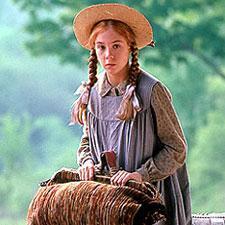The most important figure in Canadian literature is a plucky orphan. Really, the reason people think of Canadian literature as its own thing, initially—yes, there’s a lot of Canadian literature since then, but she’s the first book known for being Canadian. It’s about a girl with “starry grey eyes” who hates her red hair and freckles, who is “heedless and impulsive.” She lives on Prince Edward Island and seldom ventures from it—she goes to Europe as an adult, but it’s between books. She visits Nova Scotia; in fact, she was canonically born there and spends one book there, as a college student. But in her first book, it’s all Prince Edward Island.
Anne Shirley is introduced to eyes through the eyes of Matthew Cuthbert. He is an aging, shy man who lives alone with his sister, Marilla, on their farm of Green Gables in the town of Avonlea. A woman of their acquaintance has gone to get a child from an orphanage, and Matthew and Marilla agree that she should get them a boy, to do work around the farm. Instead, she brings them Anne, who is bright and friendly and loving—and talks a blue streak and seemingly never thinks before she acts. Despite initially telling her that she will have to go back, Matthew and Marilla come to love her.
Anne has had a truly awful childhood before coming to the Cuthberts’. It’s hard to remember sometimes that she is only eleven; the last “home” she had before Green Gables was one where she was expected to do the work of caring for a truly enormous number of children, including multiple sets of twins. By all accounts, she did it, too. She had no real friends. She was worked very hard and from what we can tell never actually loved. Indeed, it seems likely that the people who were her guardians barely even considered that she was someone who could even be liked.
At Green Gables, the world opens for her. She’s sent to school, possibly for the first time in her life. She’s managed to struggle through an education and is an extremely bright girl, but in Avonlea, she is able to sit next to her “bosom friend,” Diana Barry, and make friends with the other students, including Jane Andrews and Ruby Gillis. She famously smashes her slate over the head of school flirt Gilbert Blythe, when he calls her “Carrots,” and she has a long rivalry with Josie and Gertie Pye. In fact, Anne’s world is richly populated with characters, such that every name reminds you of someone else to mention.
Anne, unlike many other children’s heroines of her era, is far from being all sweetness and light. She’s barely been at Green Gables a week before she’s in trouble for insulting the tart-tongued woman next door, Mrs. Rachel Lynde, though Marilla freely admits that Rachel started it. She never in eight books resigns herself to having red hair; one imagines that she’s a woman of her era who doesn’t regret going grey, when she eventually does. She manages to scare herself silly over the “Haunted Wood,” a perfectly ordinary patch of woodland that she and Diana have populated with more ghosts than you’d think could possibly exist on PEI.
One of the nicest things in in Anne’s new life is her love of Matthew. He is probably in his sixties, and he’s so painfully shy that any number of people have known him all their lives and have never heard him say a single word. She dearly loves Marilla, but Matthew is the first person that she can remember ever loving her, and she warms to him as she would no one in her life, though it’s in her nature to love as many people as possible. Matthew is the first person who ever wants her to be happy, and she will love and cherish his memory—her first son will eventually be named James Matthew.
Anne of Green Gables is funny and charming and painful and heartwarming. As a child, I sympathized with Anne a lot; I, too, had gotten so distracted by my own imagination that I didn’t do things I was supposed to do. I wasn’t fond of my name, and I doubt I would’ve been able to get anyone to call me Cordelia, either; I think Anne would’ve been delighted to know that I eventually did start getting people to call me a name I liked better. Anne talks a lot about “kindred spirits,” and I think that’s what she and I are. It’s a little disappointing to me that she’s been thought of for so long as just for girls.
Help feed my own creative, talkative kids by supporting my Patreon or Ko-fi!

